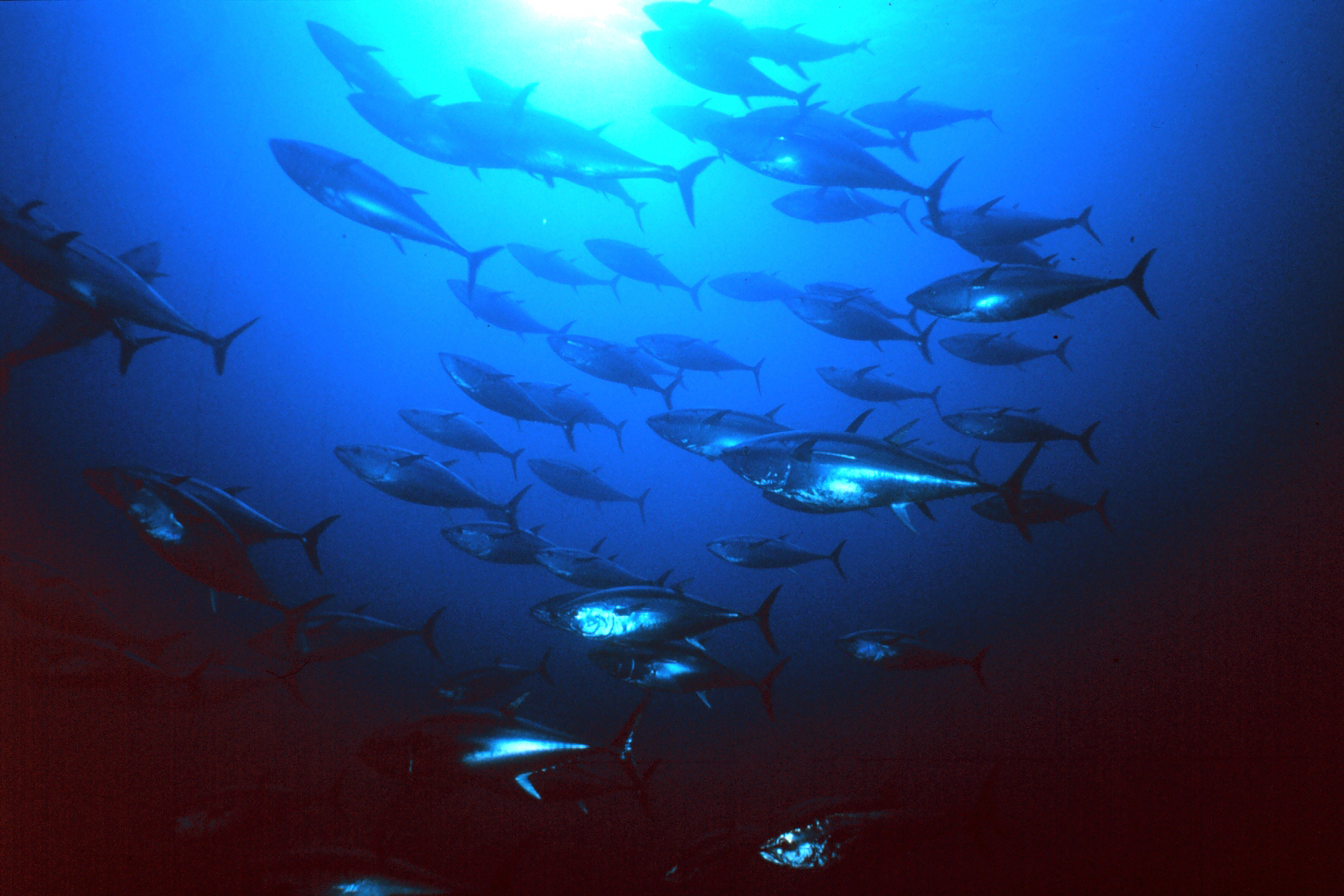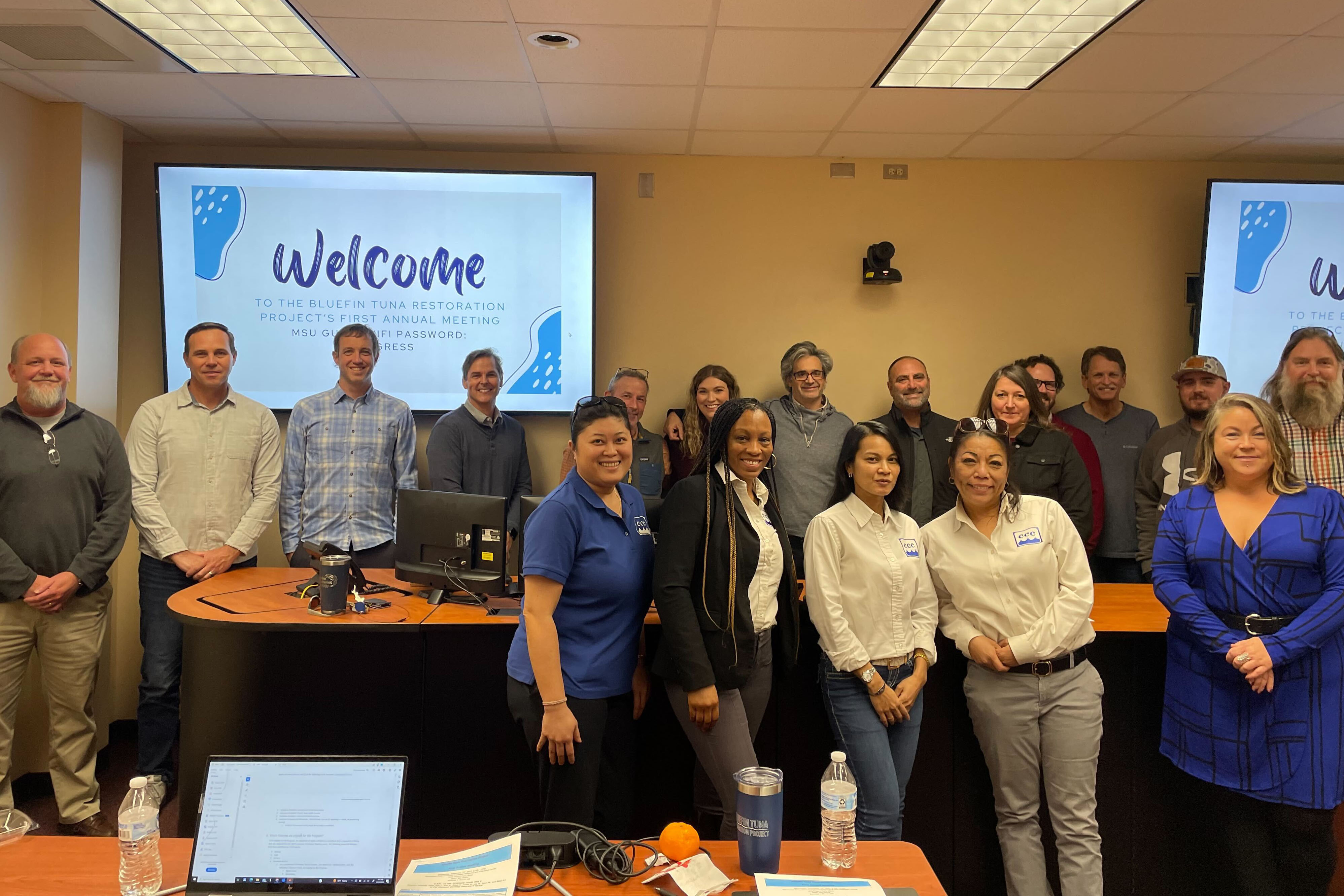Researchers and Fishing Community Tackle Bluefin Tuna Bycatch
March 7, 2024

Bluefin tuna grow slowly, taking about 8 years to reach maturity, and can reach up to 13 feet long and 2,000 pounds. Built for speed, bluefin tuna have torpedo-shaped bodies and retractable fins that help them reach 40+ mph. Credit: NOAA Fisheries
Marine animals that are unintentionally hooked on or entangled in fishing gear are called bycatch. Though usually released, these animals are often injured or die, which reduces the potential to replenish overfished stocks and increases risks to protected species. A grant from the National Oceanic and Atmospheric Administration (NOAA) National Marine Fisheries Service is funding a collaborative effort between researchers with the Northern Gulf Institute (NGI) at Mississippi State University (MSU) and U.S. Gulf Coast commercial fishing captains to reduce bluefin tuna bycatch in the Gulf of Mexico.
"We're really excited about this effort," said Dr. Marcus Drymon, a marine fisheries ecologist and MSU Associate Extension Professor. "These fishermen have a lifetime of on-the-water experience and including them as partners is a true co-production of applied science to address bycatch concerns."
Bycatch occurs when commercial fishermen use non-selective gear, such as longlines, trawl nets, and gillnets, that are designed to catch the greatest quantity of fishes in one simultaneous effort. Specifically, longlines have hundreds of baited hooks suspended from a mainline that can stretch up to 40 miles to catch commercially valuable fishes, such as swordfish, yellowfin tuna, and other tunas. However, longlines also catch more than 80 species that cannot be sold or are protected, including endangered sea turtles, game fishes like white marlin, and depleted western Atlantic bluefin tuna.
Bluefin tuna bycatch in the Gulf of Mexico is particularly concerning because this area is the only known spawning ground for the western Atlantic population of bluefin tuna. Additionally, Gulf of Mexico bluefin tuna were historically overfished and are still recovering from the 2010 Deepwater Horizon oil spill. To help reduce bluefin tuna bycatch, Drymon and his research team are working with commercial fishing captains – specifically, pelagic longliners – to test a method called "fishing depth optimization."

A recent gathering of those involved in the project titled Restoring for Bluefin Tuna via Fishing Depth Optimization included (L-R back row) Read Hendon, David Wells, Michael Dance, Jay Rooker, Brett Falterman, Abby Vaughn, James Reinhardt, Marcus Drymon, Amy Piko, Dan Van Nostrand, Dan Foster, Bryan Wescovich, Eric Orbesen and (L-R front row) Anne Nguyen, Katrina Williams, Cristina Duong, Sandy Nguyen, and Sascha Cushner. Credit: MSU Marine Fisheries Ecology Program
The idea for optimizing fishing depth originated from pop-up satellite archival tag (PSAT) data that indicated bluefin tuna normally swim in a relatively narrow depth range of 50 – 110 meters and yellowfin tuna usually swim in a wider depth range of 30 – 200 meters. Since the pelagic longliners primarily target yellowfin tuna, this project is investigating if dropping hooks beyond 110 meters would result in fewer bluefin tuna being inadvertently caught without reducing yellowfin tuna catch rates.
The fishing depth optimization technique, if successful in reducing bluefin tuna bycatch, might also increase catch rates of targeted fishes and, thus, profit. If so, in addition to promoting conservation of bluefin tuna, the fishing community could be economically motivated to voluntarily adopt this new technique.
While testing the depth optimization technique during these offshore fishing expeditions, NOAA Fisheries observers are opportunistically deploying 40 PSATs on yellowfin and bluefin tuna to better understand the migration and behavioral patterns of these valuable fishes.
The project team intends to share insights gained as the project unfolds to inform future collaborative efforts that support fisheries conservation and sustainability. "As this cooperative research continues, it is exciting to see how the project is evolving as we incorporate feedback from the participating captains," said Drymon.
The project's federal partners are the NOAA Fisheries Office of Habitat Conservation– Restoration Center, the Office of Sustainable Fisheries, and the Southeast Fisheries Science Center's Pelagic Observer Program.
In addition to MSU, the project's academic partners are the Gulf Research Institute for Highly Migratory Species (GRIHMS) at Texas A&M University (TAMU) and at Louisiana State University (LSU) and the Mississippi-Alabama Sea Grant Consortium (MASGC).
More information about bluefin tuna is available at the NOAA Fisheries webpage for
Western Atlantic Bluefin Tuna and at this recent
Gulf Coast Fisherman's newsletter.
************
NOAA Fisheries
Office of Habitat Conservation protects and restores habitat to sustain fisheries, recover protected species, and maintain resilient coastal ecosystems and communities.
NOAA Fisheries
Office of Sustainable Fisheries supports the implementation of the Magnuson-Stevens Fishery Conservation and Management Act (MSA), manages fisheries for Atlantic highly migratory species, and helps ensure the safety of seafood sold in the United States.
NOAA Fisheries
Southeast Pelagic Observer Program monitors a mobile United States pelagic longline fleet ranging from Newfoundland along the Western Atlantic, to Brazil and throughout the Gulf of Mexico. The program's observers gather data to evaluate the harvest and status of pelagic fish stocks.
The
Gulf Research Institute for Highly Migratory Species performs studies that fill critical data gaps in the habitat requirements, life history, and dispersive behaviors of highly migratory species in the Gulf of Mexico to support healthy and sustainable fisheries and the region's blue economy.
The
Northern Gulf Institute is a NOAA Cooperative Institute with six academic institutions located across the US Gulf Coast states, conducting research and outreach on the interconnections among Gulf of Mexico ecosystems for informed decision making. One of NGI's four research themes is Ecosystem Management that promotes and enables an ecosystem-based approach to fisheries management.
By
Nilde Maggie Dannreuther and
Marcus Drymon with the Northern Gulf Institute, Mississippi State University.

